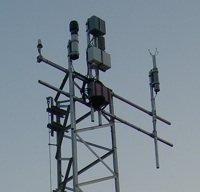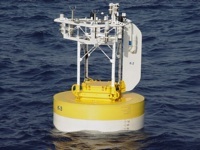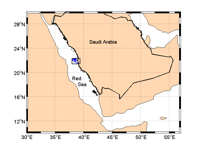WHOI-KAUST Red Sea mooring
Overview
King Abdullah University of Science and Technology (KAUST), a world-class, graduate-level scientific research university now under development, has an agreement with the Woods Hole Oceanographic Institution (WHOI) to collaborate on marine research projects in the Red Sea.
KAUST Marine and Ocean Research Center, which will provide critical information about ocean ecosystems, fisheries, and water circulation along the coast in the northern central Red Sea, has sponsored the UOP-KAUST reference station.
Beginning in September, 2008, we are working with KAUST to maintain a fully-instrumented surface mooring in the eastern Red Sea. We will collect accurate time series of surface meteorology and upper ocean temperatures, velocities and salinities. The data collected will improve our understanding of the air-sea fluxes and sea-surface temperatures in the region.
The first KAUST-UOP buoy was deployed on 11 October 2008 at 1209 UTC
at approximately 22°N, 38°E in about 700 m of water. The tower is
on campus, at about 22°N 39°E.
Real-time data
Surface and near-surface data is received in near-real time using Iridium modems running Short Burst Data messaging. Please see our UOP Technotes, Buoy Telemetry and Inductive Telemetry for UOP Ocean Reference Station Moorings for more information about our Iridium telelmetry systems.
Data presented on this web site should be used with caution; it is raw data, and has not be quality controled; it is provided as a convenience and to help us monitor the instrumentation.
Meteorology and Surface Fluxes
ASIMet units 2 and 4 are transmitting hourly-averaged meteorological data in near real time from the surface buoy and from the nearby tower using the Iridium satellite service. We are developing a system to compute surface fluxes using real-time data, and these results are presented on a trial basis here.
Subsurface Temperature and Salinity
An inductive modem is transmitting data from a series of sub-surface instruments deployed on the KAUST surface buoy.
Waves
A WAMDAS wave instrument package, supplied by the National Data Buoy Center (NDBC), is deployed on the KAUST surface buoy. Data is available in edited form on the NDBC web site (station 23020), and in raw form on this site.
Sponsors:
King Abdullah University of Science and Technology (KAUST)
Principal Investigator:
Dr. J. Farrar, Upper Ocean Processes Group, Woods Hole Oceanographic Institution
Last updated: 2020/01/15




